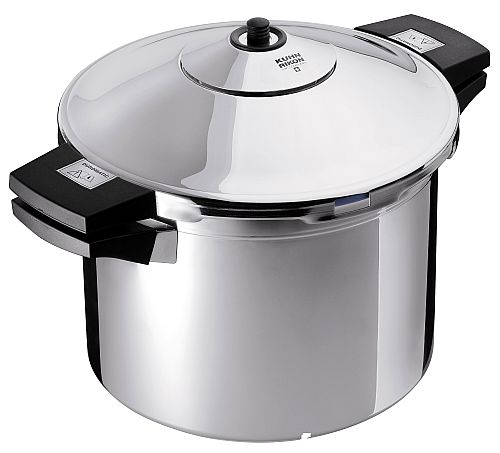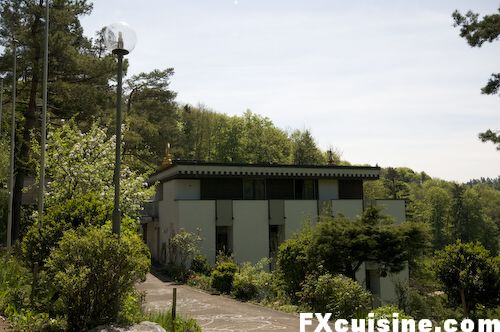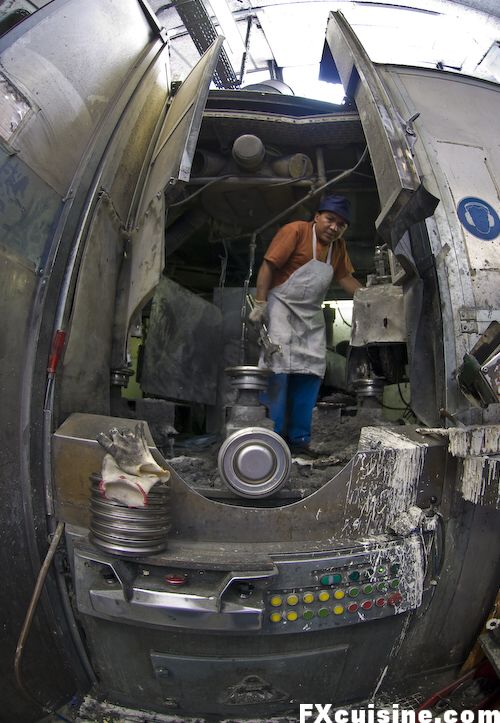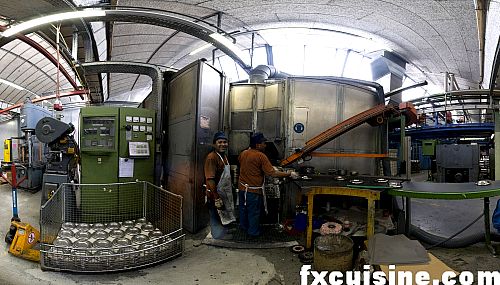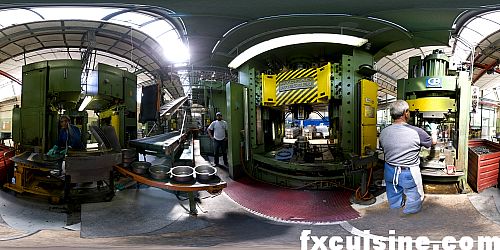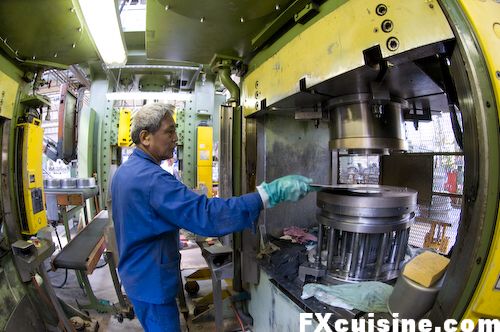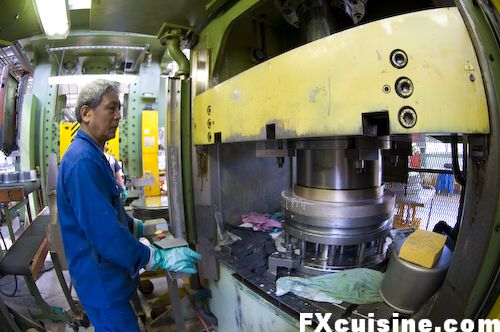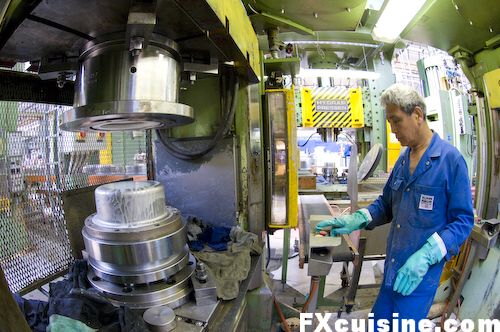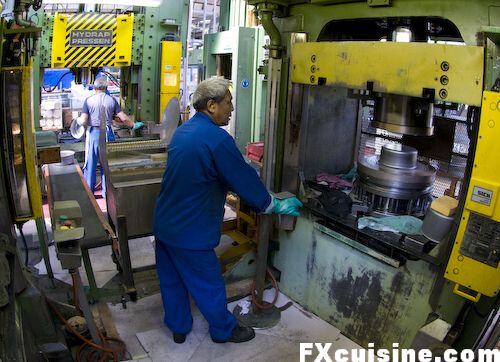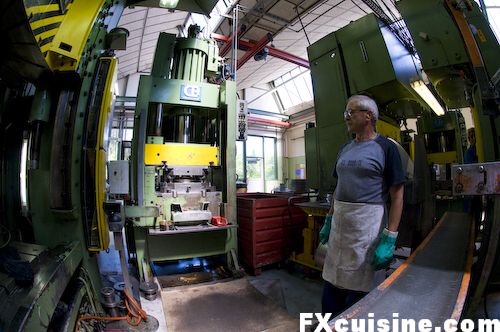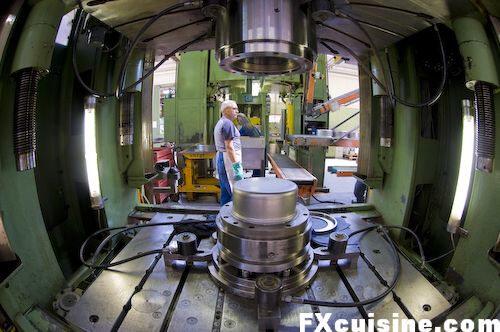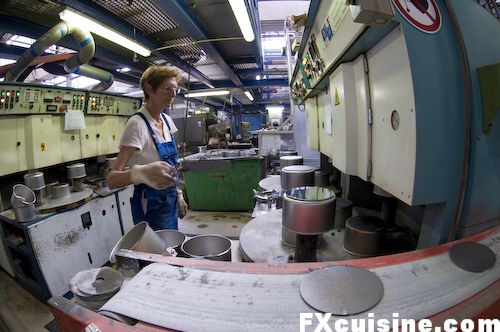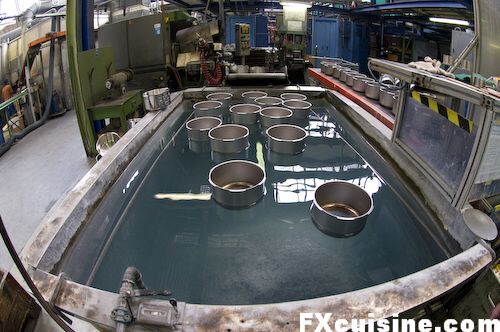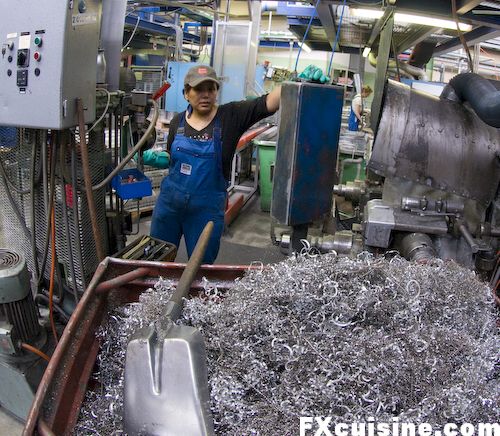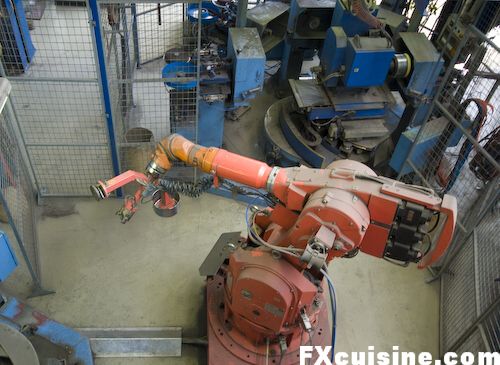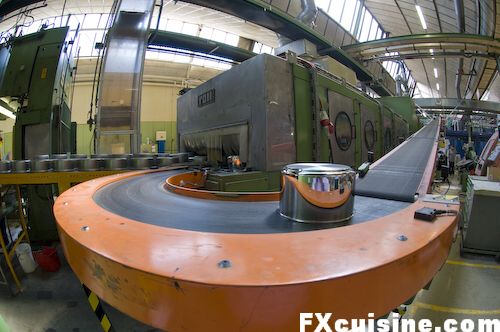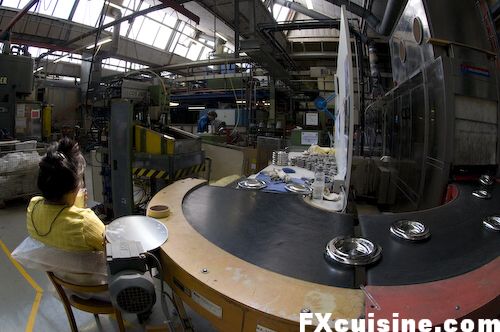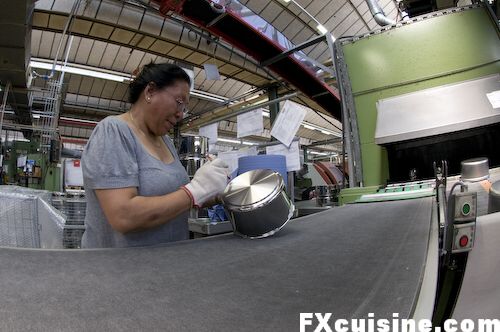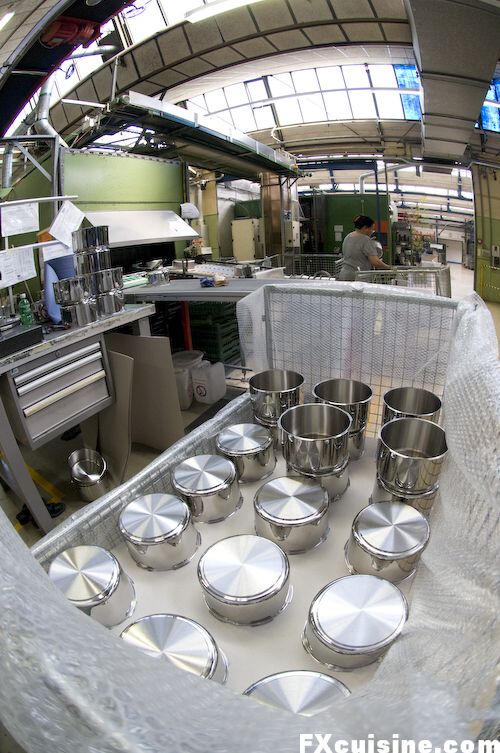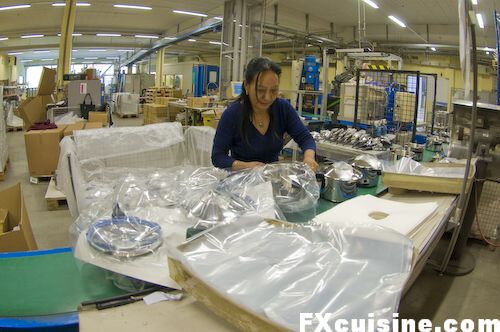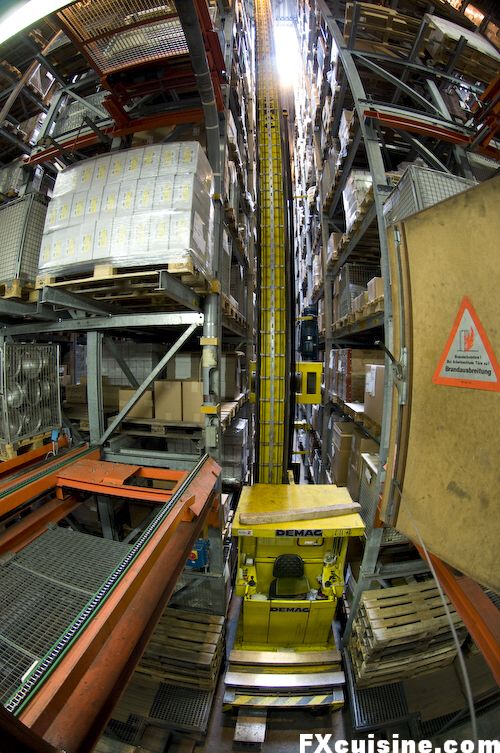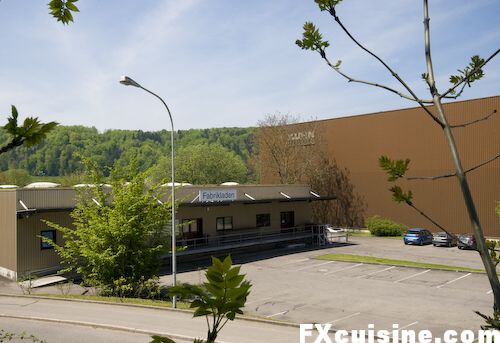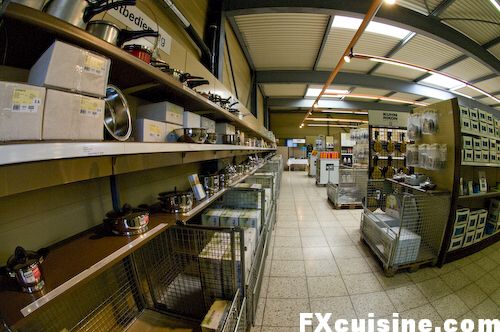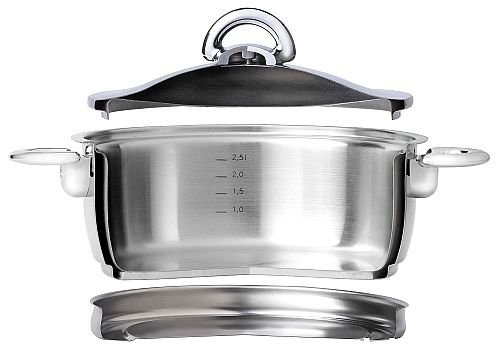注:原來對於外國的高檔炊具抱有至高的敬意,現在看來,國貨質量絕不比他們差,我們價格優惠隻是因為中國人民的勤勞肯幹。支持國貨決不隻是一個口號,隻要打破迷信,我們省錢還愛國呢。
轉自Fxcuisine.com原來他們是這樣老式工廠,而且支持達賴的。。
I was given a private tour of the Kuhn Rikon factory near Zurich, who makes some of the best cookware in the world.
The New York Times called this "The Mercedes-Benz of pressure cookers" and it's the favorite pressure cooker of Madhur Jaffrey, the English goddess of Indian cooking I had to investigate. Follow me into the factory and see how these legendary pots are made. Don't miss my 360° Quicktime Panorama (4500Kb)!
The Kuhn Rikon factory is located in a beautiful valley half an hour northeast of Zurich. As the GPS led me through tiny backroads, I could not believe the stupefying beauty of the landscape. Postcard-like farms, cows, meadows all over a rolling countryside bathed with sun. The locals certainly drew a lucky number at the cosmic lottery.
A casual glance at my pictures might lead you to believe that the factory has been secretly moved to China, for many of the employees at Kuhn Rikon are not Swiss but Tibetan. How come? Jacques and Henri Kuhn, the brothers who owned Kuhn Rikon in the late 1950s once attended a conference by Mrs Sprüngli, a chocolate industrialist much taken with Tibet. When they heard about the sorry business of the Chinese invading Tibet, ransacking the temples, imprisoning the monks and driving out the population, they decided to help the Tibetans however they could. Not by placing 'Free Tibet' stickers on the car or writing letters. Jacques Kuhn called the Red Cross, a Swiss organization that helps political refugees, and said they had plenty of free space in their employee lodgings. 'They also need a job', said the Red Cross. 'No problem, we'll hire them at the factory', answered the brothers. These Tibetan families have worked at the factory ever since. It has proved mutually beneficial, as industrial jobs in rural areas are not always easy to staff in Switzerland.
The Tibetans were a bit lost in Switzerland at first, arriving into a modern consumption society much different from the one they left at home. Seeing that his loyal Tibetan employees needed some spiritual support to face this whole new life, Jacques Kuhn called the Dalai Lama and asked if he could come and speak to his people. He did, and as a result a beautiful Tibetan temple was built in the woods above the factory. The Dalai Lama still visits regularly. All this happened decades before it was fashionable to feel for the Tibetan people. Nowadays, when you cross the village of Rikon, you see Swiss people of Tibetan descent all over the place. I even had lunch at a restaurant called 'Tibet Pizza'. If you cook with a Kuhn Rikon pot, it will have been made at some point or another by one of the descendants of these Tibetan refugees. They are all Swiss now, so if below you read 'Tibetan', it is really 'Swiss of Tibetan descent' of course. I think the factory can be proud of this and one can only wish that all refugees were like those Tibetans - hard working, modest and happy to live in this haven of peace and prosperity at the foot of the Swiss Alps.
Meet Mr Thibten Dhakyel, who just finished his adjustment in the world of dust inside the so called 'round table' machine. In the past, most pots were polished using this circular arrangement to keep the dust inside.
Mr Dhakyel feeds the machine with the lids arriving on the upper orange conveyor belt, and takes them out on the lower, green belt after processing. (2000-pixels-wide panorama, JPEG, 629Kb)
To produce mass market items in Switzerland, even of such high quality, mechanization is needed. Here is Kuhn Rikon's modern production line for the Duromatic pressure cookers. Above is a preview of a 360° Panorama (4500Kb, Quicktime) of Francesco Landi's workspace. He and his colleague Mr Dangman transform steel dics into pressure cookers using huge 10-ton press.
A chromium nickel steel disc is placed by Mr Thubten Dangma in the giant press ...
... then the press pushes down a giant piston with every last gram of its 10-ton might.
Up it goes, revealing the body of a pressure cooker, dripping from the soap liquid inside the mold. How you can turn a disc into a pan by merely pushing it into shape, I can't get my mind around. There are no tears, no cracks, no thinning around the edges. It's nothing short of miraculous.
We now leave this Tibetan gentleman to visit the other side of the press ...
... where Mr Francesco Landi, a modern-day Hephaestus, operates another press that will carve out the pressure cooker's edges so that you can lock the lid.
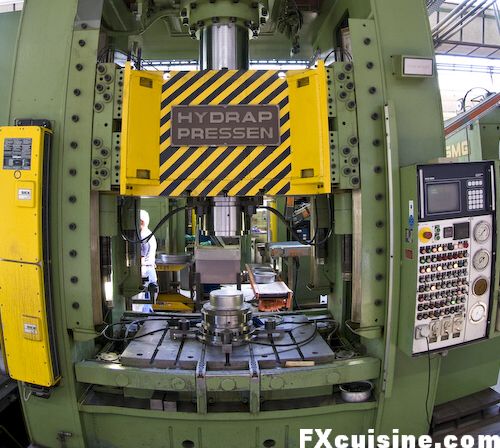
The press does not fit in a conventional kitchen! If you draw to close, a light beam detects your presence and turns it off automatically before you are turned into a human pressure cooker.
The man places one pressure cooker after the other, waits for the press to do what it does, then takes it out.
Mrs Rosmarie Werner oversees a crucial part of the production process. She takes a pressure cooker body, places it upside down on one of the three sticks in front of her, then covers the pot's bottom with an aluminium disc covered with another disc of stainless steel. The aluminium will ensure even spreading of the heat, an essential feature in any kitchen. The pot heats through induction, much like it would on a fancy induction stove, and the aluminium disk is sealed.
The lady removes the pots and places them into a cooling bath. 'That's the most high-tech part of the factory', my guide jokes, 'a plain water bath'.
At the other end of the bath the pots are milled so that the welding around the aluminium core is evened out by Mrs Danzengyuzhen Lekden. On the picture you see the scrapings.
But it's not all manual work. From now on, a string of robots take over. They are lined up in the factory the length of a city block, most of them entirely hidden in blue boxes to keep the metal dust in. The robots do the hard work - polishing. Pots arrive on a conveyor belt above the machine. The robots detects the arrival of a new pot, grabs it with a suction valve pressed flat agains the inside of the pot ...
... then swiftly moves it on a succession of wheels that gives it its beautiful shine.
End of the line, with mirror-smooth pressure cookers coming one after the other...
... while on the other side of the factory the lids arrive under the eyes of a Tibetan lady sipping some tea.
We witnessed a highly intriguing scene. This lady, Mrs Kalsang Samling, taps each pot a few times with a curious copper rod. Some propitiatory ritual to wish the users of the pot 1001 happy meals? Not quite.
She inspects each pot to see the tiniest flaw, then grades the pot from AAA - worthy of selling in regular shops to AA for those pots with a minute flaw, some microscopic discoloration you'd need a loupe and 2 hours to find. AA pots are sold in the factory shop (see below). All those below AA are destroyed.
Packing.
The pots are stored in cardboard boxes, then piled up 50 to a pallet. The pallets are moved in a huge automated warehouse with a 7000-pallet-capacity.
Here is now FXcuisine.com's hot tip. Next to the factory is a huge factory shop that sells the entire range, and then some, at a hefty discount. All pots are AA grade, which means there is somewhere a minute flaw. Most probably you'll never find it as the quality standards are very high.
I literally filled my car with Kuhn Rikon cookware (I paid for it in case you wonder!). Amazing stuff. One cast iron frying pan alone is so big you could easily feed all contestants for Star Chef for a month out of one panful only. Or sit on it and slide down a ski slope. Or bathe in it.
Kuhn Rikon makes all sorts of cookware beyond their flagship pressure cooker. Here is one of the Durotherm pots, they go for about $200 on Amazon.com. The pot is double-walled and has a thick but light lid and a double base to keep the contents hot. It's just about the smartest pot I've seen so far. You can heat up a liquid with less energy, and then keep it warm for 2 hours. I'll be back with another article soon to report on my testing this amazing technology.





